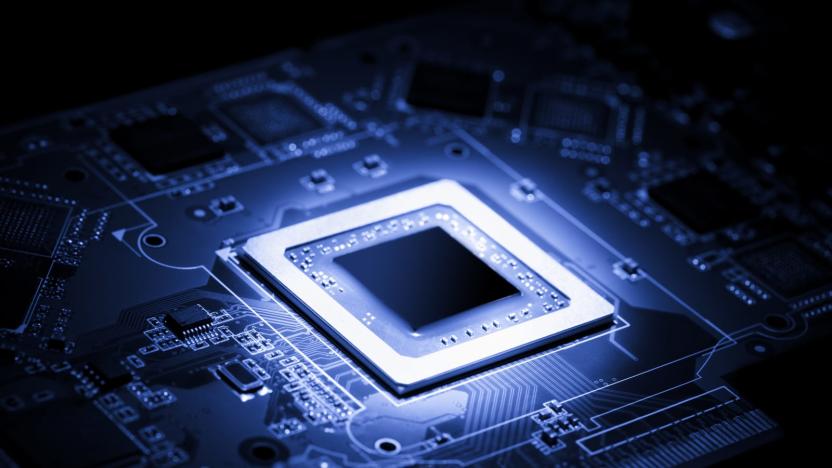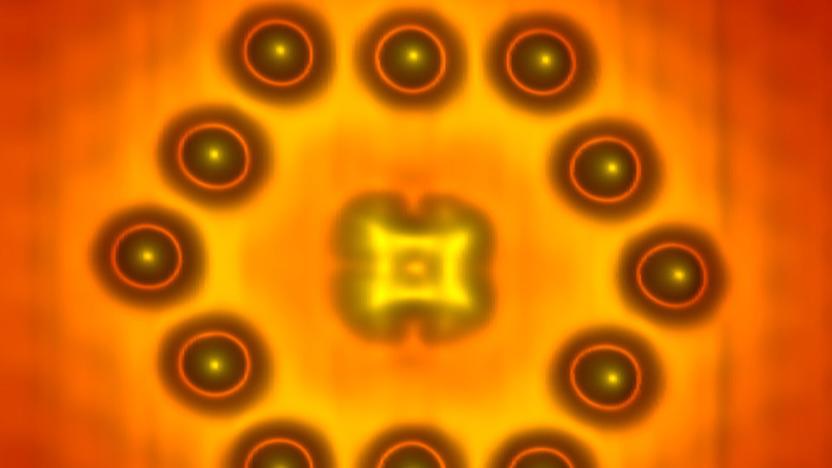circuit
Latest

Novation Circuit Tracks is a worthy successor to a beloved groovebox
The Circuit Tracks is a budget-friendly tool for getting into electronic music production and improves on the original Circuit in almost every way.

Textiles become circuits in 'The Embroidered Computer'
Google and others have developed smart clothing with built-in integrated circuits, but what if the textile itself formed the circuit? That's the idea behind The Embroidered Computer, an interactive installation from artist and researcher Irene Posch and designer/artist Ebru Kurbak , shown at this year's Instanbul Design Biennial. It's a working 8-bit electromechanical computer made from gold, linen, hematite, wood, silver and copper that functions equally as a decorative textile. As Posch notes on her website, the piece explores "the appearance of current digital and electronic technologies surrounding us, as well as our interaction with them." At the same exhibition, the artists also showed off The Yarn Recorder, a device that can record and playback sounds using steel-cored yarn.

Super-thin semiconductors delay the 'death' of silicon
Silicon has been the backbone of processors for decades, but it's rapidly approaching its physical limits: making a chip on a process smaller than 5 nanometers is usually impossible without introducing problems. How is Moore's Law for chip complexity going to survive? Stanford researchers have a solution: augment it with materials that outdo silicon where it counts. They've pinpointed two semiconductors, hafnium diselenide and zirconium diselenide, that can be made extremely thin (just three atoms thick) while self-insulating far more effectively than silicon. You could get transistors that are 10 times smaller than the smallest you get from silicon alone -- 5nm chips would seem bloated compared to what's possible with these diselenides.

Living circuits can handle complex computing
Gene-based circuits are about to get decidedly more sophisticated. MIT scientists have developed a method for integrating both analog and digital computing into those circuits, turning living cells into complex computers. The centerpiece is a threshold sensor whose gene expression flips DNA, converting analog chemical data into binary output -- basically, complex data can trigger simple responses that match the language of regular computers.

Programming language makes circuits out of bacteria
Biological circuits have been a reality for years. However, making them is no mean feat: you typically have to create everything from scratch, which is impractical for everyone but a specialized genetic engineer. MIT has a better way, though. It developed a programming language that makes it comparatively easy to produce these organic machines -- you just write code (based on existing computer instructions) and get a bacteria-friendly DNA sequence that does what you want. In the lab, sample circuits in E. coli did everything from ranking inputs to measuring oxygen levels.

Researchers create working electronics inside a rose
Plants and electronics frequently get along, but you don't see electronics in plants -- not surprisingly, it's hard to insert circuitry without killing the host. Swedish scientists just overcame one of the biggest hurdles to creating these strange cyborgs, however. They've successfully made the key elements of an electronic circuit inside of a rose and light up ions inside the flower's leaves. The trick was to insert a special polymer that self-assembled into wires throughout the stem, carrying electricity without cutting off the flow of life-giving nutrients.

Scientists make a transistor from a single molecule
You're looking at what could be not just one of the smallest semiconductor parts ever, but one of the smallest semiconductor parts possible. A worldwide research team has built a transistor that consists of a single copper phthalocyanine molecule, a dozen indium atoms and an indium arsenide backing material. The trick was to abandon the usual mechanics of a transistor, which normally controls current by modulating the gate voltage, in favor of a field effect. Here, you only need to vary the distance of the gate (in this case, the atoms) to modulate electricity.

The Crew dev blog talks Raid, Circuit, and Perf spec cars
Ubisoft's latest dev blog for open world racer The Crew is worth a read if you're partial to cars, MMO-style groups, and boss fights. It describes a takedown challenge mission called A Little Nudge that "wouldn't be out of place in a Driver game." It also mentions the Raid spec, and that's not "raid" in the typical MMO sense of the word but "raid" as in a car class designed to "tear through the hills, valleys, and backroads" of Yosemite and survive plenty of "high-speed brutality." In addition to Raid, Circuit, and Perf specs, The Crew also features 20 upgrade slots per car, which Ubisoft says will please gearheads and gamers alike.

You can draw circuit boards onto paper with this pen (video)
When dreaming up that world-changing invention, wouldn't it be great if you could just sketch out the circuits and have them magically work? That's the idea behind Circuit Scribe, a ballpoint pen that's full of quick-drying ink that'll help you doodle your circuits on notebook paper. Emerging out of research from the University of Illinois, the team is now accepting your cash through Kickstarter to help bring it into the real world. $20 will get you a pen and an LED component, while $30 will buy you a basic kit, complete with plenty of accessories to help you test the systems to their fullest. We imagine it'll be a big hit with STEM educators as well as hobbyists, but if you're not yet convinced, check out the video to watch it in action.

EX1 prints circuits on paper, cloth, almost anything you can imagine
Printing a circuit isn't exactly a new idea. In fact, researchers have been putting down silver nano particles using a process similar to ink-jet printing for years. Heck, you can even hack your existing desktop unit to do the same thing with about $300 in components. Still, a retail-ready circuit printing machine has so far managed to elude us. That's where the EX¹ hopes to make its mark. With most of the early bird specials already gone, you'll have to pledge at least $1,499 to its Kickstarter campaign to get one, which puts it firmly in prosumer territory. (And that's just for the version that requires some assembly.) But there's no denying the allure. The EX¹ uses two different "ink" cartridges to lay down layers of material that will form lines of silver nano particles. And, thanks to its flatbed design, you can print your customized circuits on anything from standard PCBs, to cloth, wood or even paper. The company has even built a custom software suite that simplifies the printing process. You can simply import an image of a circuit and hit print (they're pretty easy to find with a Google Image Search). Or, if you're feeling more adventurous, you can sketch out the circuit yourself and take control of all the printing variables. The EX¹ has already doubled its funding goal with four weeks left in its campaign. If you're interested and have the cash hit up the source to pledge your support. But be advised, you'll need to be patient -- the estimated shipping date is currently July of 2014. (And we all know how good a track record Kickstarter campaigns have at meeting shipping targets.) Before you go, make sure to check out the video after the break.

Scientists show how to make an integrated circuit using only graphene
IBM built an integrated circuit using graphene back in 2011, but it wasn't a complete breakthrough -- much of the hardware was based on old-fashioned metal and silicon. UC Santa Barbara has gone one step further by showing how to design an IC made exclusively from the advanced substance. The new process shapes circuit components from graphene ribbons whose properties change depending on the pattern; a narrow ribbon is semiconducting, while a wide ribbon is metallic. Chips designed this way should be thinner, more efficient and easier to assemble than their mixed-material counterparts. The catch? Right now, this all-graphene IC exists solely as a computer model. When there are no immediate plans for production, it could be a long while before we see the real thing.

LightUp electronic blocks and AR app teaches kids circuitry basics (hands-on)
There are plenty of kits out there designed to help kids learn the ins and outs of electronics, but LightUp hopes to stand out from the crowd with not just easy-to-use building blocks but an accompanying augmented reality app as well. From resistors and LED modules to light sensors, each block represents a real component that can be attached to each other via magnetic connectors, hopefully creating a circuit in the process. LightUp even offers an Arduino-compatible microcontroller block to help kids start coding -- clip the programming wand to the block, hook it up to your computer, and away you go. What really sets LightUp apart is the aforementioned AR app. Simply snap a picture of your circuit, and the software will let you know what's wrong with it if there's a mistake. If everything's working, it'll display an electrical flow animation atop the picture, showing kids the magic of electricity. We had a go at creating a circuit ourselves, and were delighted at how easy it was. The connectors fit in either direction, and can be attached and reattached with ease. We also saw a brief demo of the prototype application, and sure enough, it showed us when an LED block was placed backwards with an error message -- you can see it in action in the video below.

MIT crafts genetic circuits that remember their work through DNA
It's easy to find work on gene-based storage; finding genes that will do any of the heavy lifting is another matter. MIT believes it has a genetic circuit that will finally get to work, and then some. In using recombinase enzymes to alter DNA sequences serving as logic gates, researchers have developed a cellular circuit that not only mimics its silicon cousins, but has its own built-in memory. As the gate activation makes permanent changes to a given DNA sequence, any gate actions stay in memory for up to 90 generations -- and will hang around even if the cell's life is cut short. MIT sees its technique as having ultimate uses for areas where longer-term memory is important, such as environmental sensors, but could also see varying output values helping with digital-to-analog converters and other devices where there's a need for more precision. While there's no word on imminent plans for real-world use, the development raises the possibility of processors that could skip the traditional memory cache as they pass info down the family tree.

Athens university prints polymer circuits with lasers, speeds us towards low-cost electronics
The dream of ubiquitous technology revolves around cheaper materials, and polymer circuits could help make the dream a reality... if the solvents used to produce the circuits didn't cause more problems than they cured, that is. The National Technical University of Athens has developed a more exacting technique that, like most good things in science, solves the crisis with lasers. The approach fires a laser at a polymer layer (covered by quartz) to throw some of that polymer on to a receiving layer; by moving the two layers, the scientists can print virtually any 2D circuit without resorting to potentially damaging chemicals. Any leftover worries center mostly around risks of changing the chemical composition as well as the usual need to develop a reliable form of mass production. Any long-term success with laser-printed polymers, however, could lead to more affordable technology as well as more instances of flexible and wearable gear -- there might not be much of a downside to ditching the circuit status quo.

Visualized: London Underground circuit map is also a radio
London has a rich history of underground radio stations, but what if we flipped that, and turned London's Underground into a radio? Well it'd look like this. The circuit-board radio project is a collaboration between Yuri Suzuki and Masahiko Shindo, and uses Harry Beck's iconic tube map design. Note the choice of BBC's White City for the tuner, and Hyde Park's Speaker's Corner for volume control -- plus a few other famous names changed for geeky in-joke fun. We love the attention to detail, we just hope it's not permanently tuned to Capital FM.

CircuitLab brings schematic design and sharing to the browser (video)
The designs for all those wonderful Arduino and electronics projects don't create themselves, sadly. No, a person needs to put in time and effort laying out the circuits and carefully arranging the components, often by hand, but sometimes with aid of a software tool. A new player in that field is CircuitLab, a surprisingly full featured app for sketching out schematics and simulating them that lives entirely in the browser. It's also amazingly user friendly and simple for even the novice hobbyist to dive into. Finally, once you've finished with your project you can make the design public and share it with others. Check out the quick intro video after the break and sign up at the source.

NES controller lets you stomp Koopas, save Princess Peach in capacitive fashion (video)
Is your NES controller in another castle? Maybe you're just pining for your smartphone's capacitive game controls for some reason. Regardless, here's a little piece of tech that just might put the fire in your flower: the capacitive touch NES controller. This sucker is milled from a copper board using a device called the MezzoMill, which -- besides making turtle-stomping peripherals -- also can be used to produce guitar effect pads, virtual keyboards, bicycle rim lights and all sorts of circuits that might tickle your fancy. Unfortunately, the creator isn't as well-funded as this inkjet-based control circuit project so he's trying to raise money through Kickstarter to make the mill in a large enough run to lower costs. Given how Kickstarter generated nearly $100 million in funding last year, maybe he's got a fighting chance. See the buttonless controller work its capacitive magic after the break.

Researchers print a fully-functional OLED control circuit using an inkjet
Don't worry, this isn't about teaching bacteria how to climb out of a petri dish and follow a subway map. The picture above actually shows an OLED display control circuit that was quickly and cheaply manufactured thanks to the joys of inkjet printing. Its makers at UCLA start-up Aneeve Nanotechnologies also claim their carbon nanotube circuit yields better performance than traditional silicon counterparts and should therefore be considered a competing technology. On the other hand, it's also true that inkjet circuitry has been around in various forms for years, so we must return to the fundamental question: will we ever be able to afford one of these?

MIT slinks into a cafe, orders a side of photonic chips on silicon
Whiz-kids the world over have been making significant progress on the development of photonic chips -- devices that "use light beams instead of electrons to carry out their computational tasks." But now, MIT has taken the next major leap, filling in "a crucial piece of the puzzle" that just might allow for the creation of photonic chips on the standard silicon material that underlies most of today's electronics. Today, data can travel via light beams shot over through optical fibers, and once it arrives, it's "converted into electronic form, processed through electronic circuits and then converted back to light using a laser." What a waste. If MIT's research bears fruit, the resulting product could nix those extra steps, allowing the light signal to be processed directly. Caroline Ross, the Toyota Professor of Materials Science and Engineering at MIT, calls it a diode for light; to construct it, researchers had to locate a material that was both transparent and magnetic. In other words, a material that only exists in the Chamber of Secrets. Hit the source link for the rest of the tale.

MIT unveils computer chip that thinks like the human brain, Skynet just around the corner
It may be a bit on the Uncanny Valley side of things to have a computer chip that can mimic the human brain's activity, but it's still undeniably cool. Over at MIT, researchers have unveiled a chip that mimics how the brain's neurons adapt to new information (a process known as plasticity) which could help in understanding assorted brain functions, including learning and memory. The silicon chip contains about 400 transistors and can simulate the activity of a single brain synapse -- the space between two neurons that allows information to flow from one to the other. Researchers anticipate this chip will help neuroscientists learn much more about how the brain works, and could also be used in neural prosthetic devices such as artificial retinas. Moving into the realm of "super cool things we could do with the chip," MIT's researchers have outlined plans to model specific neural functions, such as the visual processing system. Such systems could be much faster than digital computers and where it might take hours or days to simulate a simple brain circuit, the chip -- which functions on an analog method -- could be even faster than the biological system itself. In other news, the chip will gladly handle next week's grocery run, since it knows which foods are better for you than you ever could.










